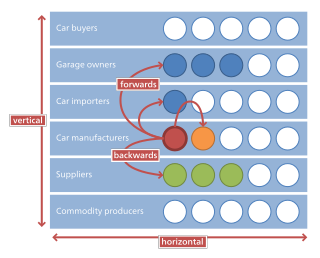Related Research Articles

In commerce, supply chain management (SCM) deals with a system of procurement, operations management, logistics and marketing channels, so that the raw materials can be converted into a finished product and delivered to the end customer. A more narrow definition of the supply chain management is the "design, planning, execution, control, and monitoring of supply chain activities with the objective of creating net value, building a competitive infrastructure, leveraging worldwide logistics, synchronising supply with demand and measuring performance globally". This can include the movement and storage of raw materials, work-in-process inventory, finished goods, and end to end order fulfilment from the point of origin to the point of consumption. Interconnected, interrelated or interlinked networks, channels and node businesses combine in the provision of products and services required by end customers in a supply chain.

Logistics is a part of supply chain management that deals with the efficient forward and reverse flow of goods, services, and related information from the point of origin to the point of consumption according to the needs of customers. Logistics management is a component that holds the supply chain together. The resources managed in logistics may include tangible goods such as materials, equipment, and supplies, as well as food and other consumable items.

A supply chain, sometimes expressed as a "supply-chain", is a complex logistics system that consists of facilities that convert raw materials into finished products and distribute them to end consumers or end customers. Meanwhile, supply chain management deals with the flow of goods within the supply chain in the most efficient manner.

Horizontal integration is the process of a company increasing production of goods or services at the same level of the value chain, in the same industry. A company may do this via internal expansion, acquisition or merger.

In microeconomics, management and international political economy, vertical integration is an arrangement in which the supply chain of a company is integrated and owned by that company. Usually each member of the supply chain produces a different product or (market-specific) service, and the products combine to satisfy a common need. It contrasts with horizontal integration, wherein a company produces several items that are related to one another. Vertical integration has also described management styles that bring large portions of the supply chain not only under a common ownership but also into one corporation.
In the field of management, strategic management involves the formulation and implementation of the major goals and initiatives taken by an organization's managers on behalf of stakeholders, based on consideration of resources and an assessment of the internal and external environments in which the organization operates. Strategic management provides overall direction to an enterprise and involves specifying the organization's objectives, developing policies and plans to achieve those objectives, and then allocating resources to implement the plans. Academics and practicing managers have developed numerous models and frameworks to assist in strategic decision-making in the context of complex environments and competitive dynamics. Strategic management is not static in nature; the models can include a feedback loop to monitor execution and to inform the next round of planning.
A value chain is a progression of activities that a firm operating in a specific industry performs in order to deliver a valuable product to the end customer. The concept comes through business management and was first described by Michael Porter in his 1985 best-seller, Competitive Advantage: Creating and Sustaining Superior Performance.
The idea of the value chain is based on the process view of organizations, the idea of seeing a manufacturing organization as a system, made up of subsystems each with inputs, transformation processes and outputs. Inputs, transformation processes, and outputs involve the acquisition and consumption of resources – money, labour, materials, equipment, buildings, land, administration and management. How value chain activities are carried out determines costs and affects profits.
Agribusiness is the industry, enterprises, and the field of study of value chains in agriculture and in the bio-economy, in which case it is also called bio-business or bio-enterprise. The primary goal of agribusiness is to maximize profit while satisfying the needs of consumers for products related to natural resources such as biotechnology, farms, food, forestry, fisheries, fuel, and fiber.
A value network is a graphical illustration of social and technical resources within/between organizations and how they are utilized. The nodes in a value network represent people or, more abstractly, roles. The nodes are connected by interactions that represent deliverables. These deliverables can be objects, knowledge or money. Value networks record interdependence. They account for the worth of products and services. Companies have both internal and external value networks.

Business-to-business is a situation where one business makes a commercial transaction with another. This typically occurs when:
A lead time is the latency between the initiation and completion of a process. For example, the lead time between the placement of an order and delivery of new cars by a given manufacturer might be between 2 weeks and 6 months, depending on various particularities. One business dictionary defines "manufacturing lead time" as the total time required to manufacture an item, including order preparation time, queue time, setup time, run time, move time, inspection time, and put-away time. For make-to-order products, it is the time between release of an order and the production and shipment that fulfill that order. For make-to-stock products, it is the time taken from the release of an order to production and receipt into finished goods inventory.
Supplier relationship management (SRM) is the systematic, enterprise-wide assessment of suppliers' strengths, performance and capabilities with respect to overall business strategy, determination of what activities to engage in with different suppliers, and planning and execution of all interactions with suppliers, in a coordinated fashion across the relationship life cycle, to maximize the value realized through those interactions. The focus of supplier relationship management is the development of two-way, mutually beneficial relationships with strategic supply partners to deliver greater levels of innovation and competitive advantage than could be achieved by operating independently or through a traditional, transactional purchasing arrangement. Underpinning disciplines which support effective SRM include supplier information management, compliance, risk management and performance management.
Supply-chain operations reference (SCOR) model is a process reference model developed and endorsed by the Supply-Chain Council as the cross-industry, standard diagnostic tool for supply chain management. The SCOR model describes the business activities associated with satisfying a customer's demand, which include plan, source, make, deliver, return and enable. Use of the model includes analyzing the current state of a company's processes and goals, quantifying operational performance, and comparing company performance to benchmark data. SCOR has developed a set of metrics for supply chain performance, and Supply Chain Council members have formed industry groups to collect best practices information that companies can use to elevate their supply chain models.

A supply-chain network (SCN) is an evolution of the basic supply chain. Due to rapid technological advancement, organizations with a basic supply chain can develop this chain into a more complex structure involving a higher level of interdependence and connectivity between more organizations, this constitutes a supply-chain network.
Third-party logistics is an organization's long term commitment of outsourcing its distribution services to third-party logistics businesses.
A global value chain (GVC) refers to the full range of activities that economic actors engage in to bring a product to market. The global value chain does not only involve production processes, but preproduction and postproduction processes.

This article outlines the evolution of management systems. A management system is the framework of processes and procedures used to ensure that an organization can fulfill all tasks required to achieve its objectives.
Global Production Networks (GPN) is a concept in developmental literature which refers to "the nexus of interconnected functions, operations and transactions through which a specific product or service is produced, distributed and consumed."
Co-opetition or coopetition – simultaneous competition and cooperation – is an important philosophy or strategy that goes beyond the conventional rules of competition and cooperation to achieve advantages of both. Global co-opetition, an application of co-opetition in a global context, is first systematically addressed in Luo’s (2004) book “Coopetition in international business”. According to this book, global co-opetition refers to the simultaneous competition and cooperation between multinational enterprises (MNEs) and their geographically dispersed business stakeholders such as global rivals, global suppliers, global distributors, global alliance partners, and foreign governments as well as among foreign subsidiaries within an MNE.
In supply chain management, supply chain collaboration is defined as two or more autonomous firms working jointly to plan and execute supply chain operations. It can deliver substantial benefits and advantages to collaborators. It is known as a cooperative strategy when one or more companies or business units work together to create mutual benefits. There are two main types of supply chain collaboration: vertical collaboration and horizontal collaboration. Vertical collaboration is the collaboration when two or more organizations from different levels or stages in supply chain share their responsibilities, resources, and performance information to serve relatively similar end customers; while horizontal collaboration is an inter-organizational systemrelationship between two or more companies at the same level or stage in the supply chain in order to allow greater ease of work and cooperation towards achieving a common objective.
References
- 1 2 3 4 Lazzarini, Sergio G.; Chaddad, Fabio R.; Cook, Michael L. (June 2001). "Integrating supply chain and network analyses: The study of netchains". Journal on Chain and Network Science. 1 (1): 7–22. CiteSeerX 10.1.1.111.3851 . doi:10.3920/JCNS2001.x002.
- 1 2 Hofstede, G. J. (September 2006). "Experimental learning in chains and networks". Production Planning & Control. 17 (6): 543–546. doi:10.1080/09537280600866561.
- ↑ Murray, LaToya J. "Three Types of Interdependence in an Organizational Structure". Chron.
- 1 2 Storer, Christine E.; Holmen, Elsebeth; Pedersen, Ann‐Charlott (December 2003). "Exploration of customer horizons to measure understanding of netchains". Supply Chain Management. 8 (5): 455–466. doi:10.1108/13598540310500286.
- ↑ Talamini, Edson; Ferreira, Gabriel Murad Velloso (2010). "Merging netchain and social network: Introducing the'social netchain' concept as an analytical framework in the agribusiness sector". African Journal of Business and Management. 4 (13): 2991–2993.